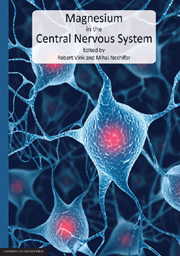Book contents
- Frontmatter
- List of Contributors
- Preface
- Contents
- Section 1 Magnesium in Normal Brain
- Section 2 Magnesium in Neurological Diseases
- Chapter 7 The role of magnesium therapy in learning and memory
- Chapter 8 The role of magnesium in headache and migraine
- Chapter 9 Magnesium in edema and blood-brain barrier disruption
- Chapter 10 Magnesium and hearing loss
- Chapter 11 The role of magnesium in pain
- Chapter 12 The role of magnesium in traumatic CNS injury
- Chapter 13 The use of magnesium in experimental cerebral ischaemia
- Chapter 14 Magnesium in subarachnoid hemorrhage
- Chapter 15 Magnesium in clinical stroke
- Chapter 16 Magnesium in cancer: more questions than answers
- Chapter 17 Magnesium in Parkinson's disease: an update in clinical and basic aspects
- Section 3 Involvement of Magnesium in Psychiatric Diseases
Chapter 13 - The use of magnesium in experimental cerebral ischaemia
from Section 2 - Magnesium in Neurological Diseases
Published online by Cambridge University Press: 05 June 2012
- Frontmatter
- List of Contributors
- Preface
- Contents
- Section 1 Magnesium in Normal Brain
- Section 2 Magnesium in Neurological Diseases
- Chapter 7 The role of magnesium therapy in learning and memory
- Chapter 8 The role of magnesium in headache and migraine
- Chapter 9 Magnesium in edema and blood-brain barrier disruption
- Chapter 10 Magnesium and hearing loss
- Chapter 11 The role of magnesium in pain
- Chapter 12 The role of magnesium in traumatic CNS injury
- Chapter 13 The use of magnesium in experimental cerebral ischaemia
- Chapter 14 Magnesium in subarachnoid hemorrhage
- Chapter 15 Magnesium in clinical stroke
- Chapter 16 Magnesium in cancer: more questions than answers
- Chapter 17 Magnesium in Parkinson's disease: an update in clinical and basic aspects
- Section 3 Involvement of Magnesium in Psychiatric Diseases
Summary
Abstract
The rationale for trialing magnesium as a neuroprotective agent following cerebral ischemia has been based both on its role in maintaining brain tissue homeostasis and on its known cellular actions that are likely to counteract damaging ischemic processes. A number of studies using animal models of cerebral ischemia, seizure, perinatal hypoxia-ischemia, subarachnoid hemorrhage and traumatic brain injury have reported positive outcomes with magnesium therapy. However, scrutiny of the animal cerebral ischemia data shows that about 46% of studies have not shown a neuroprotective effect. Furthermore, the IMAGES clinical trial found magnesium to be largely ineffective in treating strokes. In this review, we present the majority of published cerebral ischemia animal studies (focal and global) that have used magnesium as a neuroprotective therapy, and discuss the possible reasons for the inconsistent results. Our examination suggests that, in the majority of experiments, post-ischemic hypothermia has probably been a confounding factor in producing the positive outcomes. In addition, experimental design has not always been appropriate with respect to magnesium dosage, and to the time and route of magnesium administration. Moreover, data from our own laboratory indicates that magnesium is only neuroprotective when combined with post-ischemic hypothermia. Finally, additional information regarding the efficacy of magnesium as a stroke treatment will be available on completion of the FAST-Mag trial, but in the meantime the neuroprotective potential of magnesium should be explored when combined with post-ischemic hypothermia, and potentially with other agents, in cerebral ischemia models.
- Type
- Chapter
- Information
- Magnesium in the Central Nervous System , pp. 181 - 192Publisher: The University of Adelaide PressPrint publication year: 2011
- 1
- Cited by

